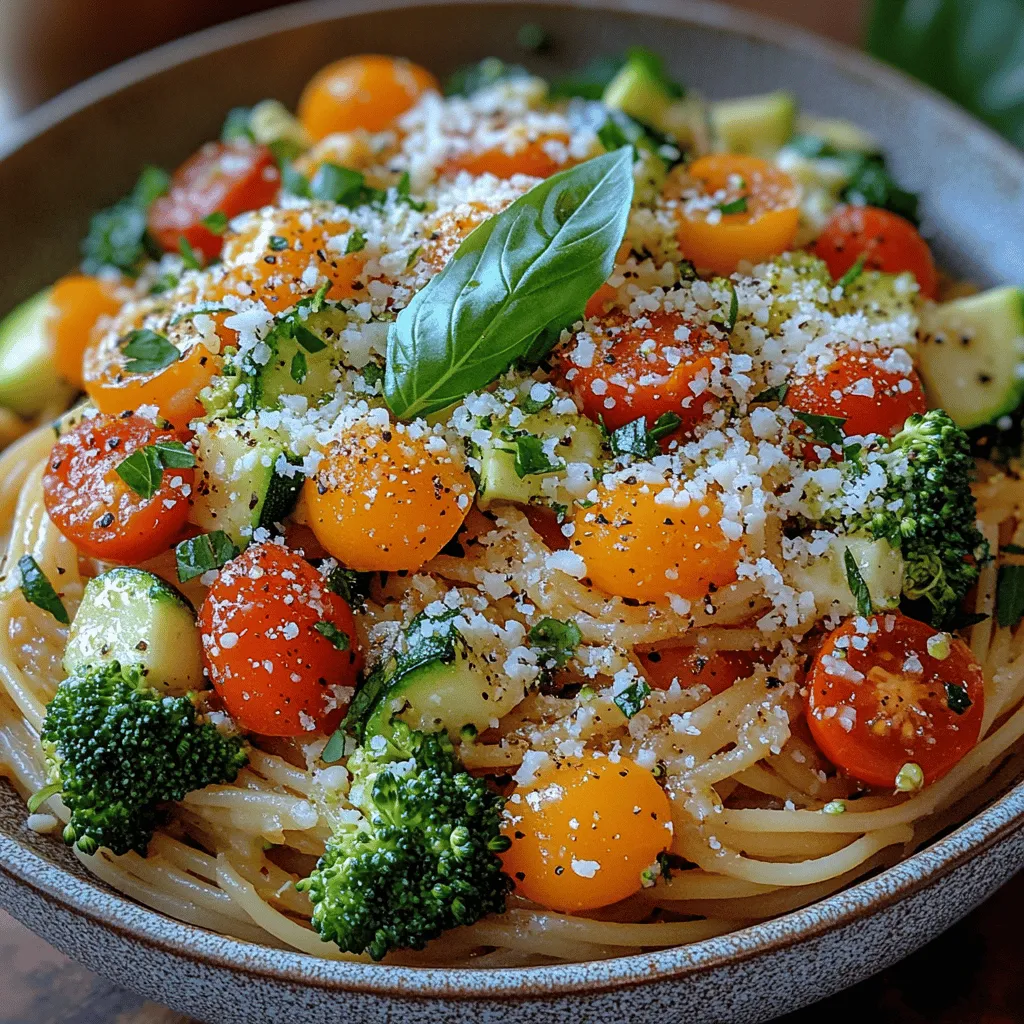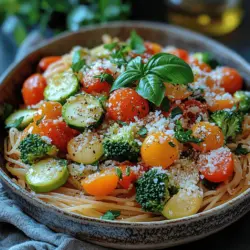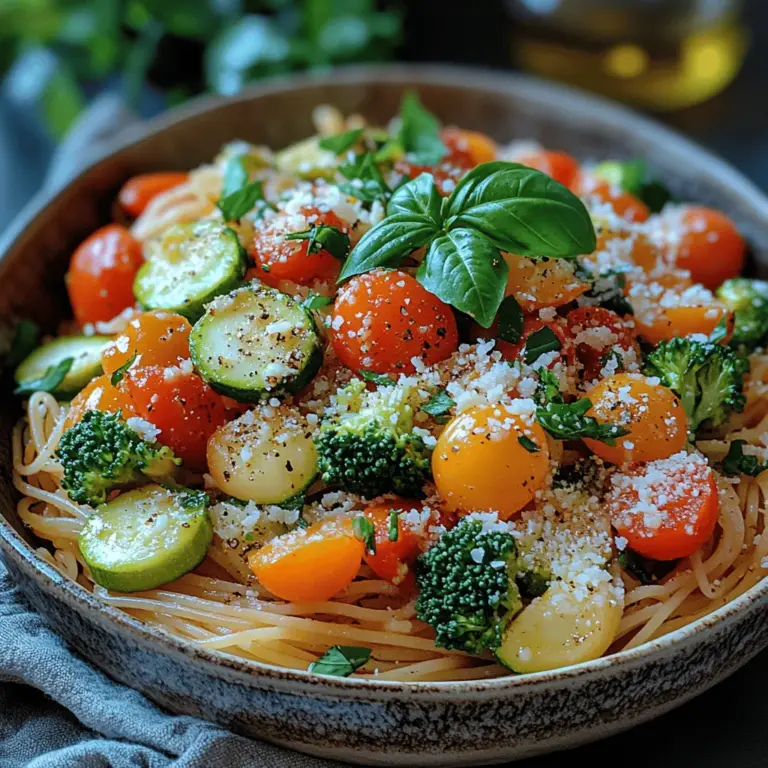Introduction
As the days grow longer and the air becomes warmer, the arrival of spring heralds a vibrant transformation in both nature and our culinary choices. Spring is the season of renewal, and what better way to celebrate its vibrant flavors than with a delightful dish like Spring Burst Pasta Primavera? This recipe encapsulates the freshness of seasonal vegetables, providing a burst of color and flavor that is both satisfying and nourishing.
Pasta Primavera, which translates to “spring pasta,” is a dish that allows the fresh produce of the season to shine. It’s an ideal choice for those seeking a quick weeknight dinner or a light lunch, as it is notably easy to prepare yet incredibly satisfying. Bursting with the bright flavors of vegetables, this pasta dish is not only a feast for the eyes but also a wholesome meal packed with nutrients.
In this article, we will explore the essential ingredients that make up this delightful recipe, delve into the cooking techniques that will ensure your pasta primavera turns out perfectly every time, and highlight the health benefits of this delicious dish. Whether you are a seasoned cook or a beginner in the kitchen, this guide will equip you with everything you need to create a meal that is both delicious and visually appealing.
Understanding the Ingredients
The success of any pasta dish lies in its ingredients, and Spring Burst Pasta Primavera is no exception. Here, we will break down the key components that come together to create this flavorful dish.
The Pasta Base: Choosing the Right Type
When it comes to pasta primavera, the choice of pasta plays a significant role in the overall texture and experience of the dish. While traditional recipes often call for spaghetti, fettuccine is another excellent option that brings a different mouthfeel to the table.
Spaghetti is a long, thin pasta that has a delicate texture. It tends to hold lighter sauces well and is perfect for letting the fresh flavors of the vegetables shine through. This type of pasta allows for a more even distribution of the sauce, ensuring that each bite is flavorful.
On the other hand, fettuccine is a broader, flat pasta that provides a heartier bite. Its shape is ideal for capturing thicker sauces and adds a satisfying chewiness to the dish. The choice between these two pasta types ultimately comes down to personal preference; however, both can serve as an excellent base for your Spring Burst Pasta Primavera.
Seasonal Vegetables: A Colorful Medley
One of the hallmarks of Pasta Primavera is the vibrant array of seasonal vegetables that contribute both flavor and nutrition. Let’s explore the individual vegetables typically used in this dish:
– Cherry Tomatoes: These bite-sized delights bring a burst of sweetness and acidity, complementing the other vegetables beautifully. Rich in vitamins A and C, cherry tomatoes also provide antioxidants that support overall health. Roasting or sautéing them enhances their natural sweetness, making them a standout ingredient in the dish.
– Bell Peppers: Available in a variety of colors, including red, yellow, and green, bell peppers add both crunch and a mild sweetness to the pasta. They are an excellent source of vitamins A and C, as well as fiber. Using a mix of colored bell peppers not only enhances the visual appeal of the dish but also maximizes its nutritional benefits.
– Zucchini: This versatile vegetable is a staple in many spring dishes. Its mild flavor and tender texture make it a perfect addition to Pasta Primavera. Zucchini is low in calories and high in vitamins C and B6, making it a healthy choice. When sautéed, it softens beautifully while retaining a slight bite, adding to the overall texture of the dish.
– Broccoli: Known as a nutritional powerhouse, broccoli is packed with vitamins K and C, fiber, and a range of antioxidants. Its slightly bitter flavor contrasts nicely with the sweetness of the other vegetables, providing depth to the dish. Lightly steaming or sautéing broccoli helps to retain its vibrant green color and crunch.
– Garlic: This aromatic ingredient is used in many Italian dishes and adds a wonderful depth of flavor. Garlic is renowned for its health benefits, including its potential to boost the immune system and promote heart health. Sautéing garlic in olive oil releases its essential oils, infusing the dish with an irresistible aroma.
Olive Oil: The Heart of Flavor
No pasta dish is complete without a drizzle of high-quality olive oil. The choice of oil can significantly impact the flavor profile of your Spring Burst Pasta Primavera. Extra virgin olive oil, in particular, is rich in healthy monounsaturated fats and antioxidants, making it a superior choice.
Using high-quality olive oil enhances the overall taste of the dish, adding a fruity, peppery richness that elevates the flavors of the vegetables and pasta. It also provides a silky texture that helps to bind the ingredients together. When selecting olive oil, look for options labeled “extra virgin” and consider choosing oils that are cold-pressed for the best flavor and health benefits.
Optional Ingredients: Personalizing Your Dish
While the core ingredients of Spring Burst Pasta Primavera create a delightful dish on their own, a few optional ingredients can further enhance the flavor profile and make the meal your own.
– Parmesan Cheese: A classic addition to many pasta dishes, freshly grated Parmesan adds a salty, nutty flavor that complements the freshness of the vegetables beautifully. It also provides a creamy texture that can make the sauce richer. For a vegetarian option, ensure that the Parmesan is made without animal rennet.
– Fresh Basil: This aromatic herb is a fantastic way to add a burst of freshness to your pasta primavera. Chopped basil sprinkled on top just before serving can elevate the dish’s flavor and aroma, creating a delightful contrast to the cooked vegetables. Basil is also known for its anti-inflammatory properties, making it a healthy addition.
As you prepare your Spring Burst Pasta Primavera, feel free to experiment with different vegetables or additional herbs and cheeses based on your preferences. This dish is wonderfully adaptable, allowing you to tailor it to your taste and the seasonal bounty available to you.
Cooking Techniques for Perfect Pasta Primavera
With the ingredients selected and ready, the next step is to explore the cooking techniques that will ensure your Spring Burst Pasta Primavera is a success.
Stay tuned to learn about the precise steps to cook your pasta, sauté the vegetables to perfection, and combine everything into a vibrant dish that embodies the spirit of spring!

Boiling the Pasta: Achieving Al Dente
Cooking pasta perfectly is crucial for any pasta dish, and achieving that ideal al dente texture will elevate your Spring Burst Pasta Primavera. To start, fill a large pot with water and bring it to a vigorous boil. A common mistake is not salting the water adequately; you should aim for a generous amount—about 1-2 tablespoons of salt for every gallon of water. This not only enhances the flavor of the pasta but also helps in maintaining its texture during cooking.
Once the water is boiling, add the pasta of your choice—opt for shapes that will hold onto the sauce well, such as fusilli or penne. Stir occasionally to prevent sticking. Follow the package instructions for cooking time, but start checking for doneness about a minute before the indicated time. The pasta should be firm to the bite, or al dente, which means it will have a slight chew that contrasts nicely with the tender vegetables you’ll be adding later.
It’s also wise to reserve about a cup of the pasta cooking water before draining it. This starchy water can be a game-changer; it acts as a natural thickener and can help emulsify the sauce, giving your dish a silky finish. Drain the pasta in a colander, but don’t rinse it—this step washes away the starch that helps the sauce cling to the pasta.
Sautéing Vegetables: Preserving Color and Nutrients
The key to vibrant and flavorful vegetables in your Pasta Primavera lies in the sautéing technique. Start by prepping your veggies—wash and chop them into bite-sized pieces. Aim for a variety of colors and textures, such as bell peppers, zucchini, asparagus, and cherry tomatoes.
Heat a large skillet over medium-high heat and add a good drizzle of olive oil. You want enough oil to coat the bottom of the pan and help achieve a nice sauté. Add the hardest vegetables first, like bell peppers and asparagus, as they take longer to cook. Sauté for about 2-3 minutes before adding softer vegetables like zucchini and cherry tomatoes.
Here’s a pro tip: Don’t overcrowd the pan. This can cause the vegetables to steam instead of sauté. If you have a lot of vegetables, consider cooking them in batches. Stir frequently but allow them to rest occasionally to develop a bit of char, enhancing their flavor.
For optimal results, keep the heat up and aim to sauté the vegetables just until they are tender yet still crisp. This technique preserves their vibrant colors and nutrients, ensuring your dish is both nutritious and visually appealing.
Combining Flavors: Integrating Pasta and Vegetables
Now that both your pasta and vegetables are perfectly cooked, it’s time to bring them together for the final assembly. In the same skillet used for the vegetables, combine the drained pasta with the sautéed veggies, tossing them gently to combine.
To integrate the flavors, add a splash of the reserved pasta water to the skillet. This not only helps to loosen the mixture but also encourages the flavors of the vegetables and pasta to meld together. For an extra burst of flavor, consider adding a squeeze of fresh lemon juice or a sprinkle of zest, which will brighten the overall taste of the dish.
If you’re a cheese lover, now is the time to add a generous handful of grated Parmesan or a plant-based alternative for vegan options. Toss everything together until the cheese melts beautifully into the mixture and everything is well combined. Taste and adjust seasoning as needed—this might include additional salt, pepper, or even a hint of red pepper flakes for heat.
Health Benefits of Spring Burst Pasta Primavera
Nutritional Advantages of Fresh Vegetables
Spring Burst Pasta Primavera is not just a feast for the eyes; it’s also packed with health benefits due to its emphasis on fresh vegetables. Each vegetable contributes a unique set of vitamins and minerals. For instance, bell peppers are high in vitamin C, which supports the immune system, while asparagus is rich in fiber and folate, essential for digestive health and cell function.
Zucchini adds hydration and a low-calorie density, making it ideal for weight management. Cherry tomatoes are full of antioxidants, particularly lycopene, which has been linked to various health benefits, including heart health. By incorporating a diverse range of vegetables, you are ensuring a well-rounded intake of essential nutrients that support overall health and well-being.
A Balanced Meal: Carbs, Fats, and Proteins
Pasta Primavera strikes a beautiful balance among macronutrients. The pasta serves as a source of complex carbohydrates, providing the energy necessary for a busy day. The olive oil used in the sautéing process contributes healthy fats that are known for their heart-health benefits.
If you wish to bump up the protein content, you can add grilled chicken, shrimp, or even chickpeas for a plant-based option. These additions not only enhance the nutritional profile of the meal but also make it more filling. This balance of carbohydrates, fats, and proteins makes Pasta Primavera a satisfying and wholesome choice for lunch or dinner.
Serving Suggestions and Pairings
Perfect Pairing: What to Serve with Pasta Primavera
To complement your Spring Burst Pasta Primavera, consider serving it alongside a light green salad. A simple arugula salad dressed with lemon vinaigrette can enhance the freshness of the meal. You might also consider crusty bread or garlic bread to soak up any remaining sauce.
For beverage pairings, a crisp white wine such as Sauvignon Blanc or Pinot Grigio works beautifully with the lightness of the dish. If you prefer non-alcoholic options, sparkling water with a hint of lemon or a refreshing herbal iced tea can also be delightful choices.
Presentation Ideas: Making Your Dish Instagram-Ready
A beautiful presentation can elevate your dining experience, making it as much a feast for the eyes as it is for the palate. Start by using a large, shallow bowl to serve your Pasta Primavera; this allows the colors to shine.
When plating, consider layering the dish: start with a base of pasta, then artfully arrange the sautéed vegetables on top. A sprinkle of freshly grated cheese or herbs like basil or parsley can add that final touch of elegance. For an additional pop of color, consider adding a few extra cherry tomatoes or a wedge of lemon on the side.
Using vibrant plates can also enhance the visual appeal—think bright colors that contrast with the greens and yellows of the dish. Take a few moments to arrange everything carefully; a little effort in presentation can make your meal feel truly special.
Conclusion
Spring Burst Pasta Primavera is more than just a meal; it’s a celebration of the season’s bounty. With its vibrant colors, fresh ingredients, and delightful flavors, this dish is sure to please any palate. Whether you’re sharing it with friends and family or enjoying a quiet dinner at home, this recipe is a wonderful way to embrace the essence of spring.
By understanding the ingredients and techniques involved, you can recreate this dish with confidence, making it a staple in your culinary repertoire. Enjoy the taste of spring with every delicious bite! As you savor this delightful pasta dish, remember that it embodies the joy of fresh produce, seasonal flavors, and the simple pleasure of a well-cooked meal.


